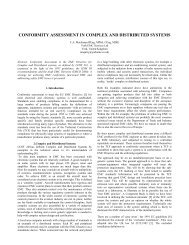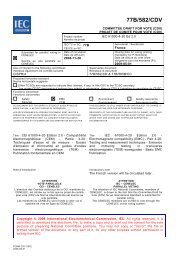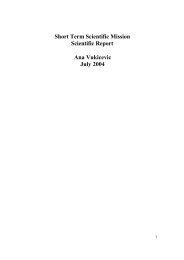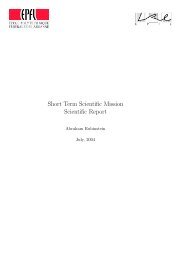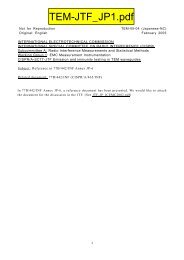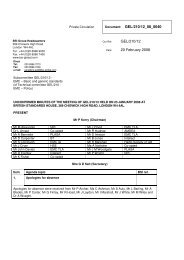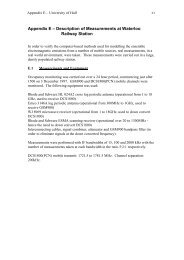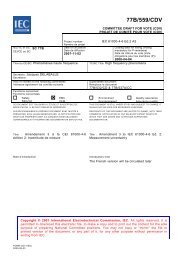Salvador Verdaguer Pascual, Host - Applied Electromagnetics ...
Salvador Verdaguer Pascual, Host - Applied Electromagnetics ...
Salvador Verdaguer Pascual, Host - Applied Electromagnetics ...
- No tags were found...
You also want an ePaper? Increase the reach of your titles
YUMPU automatically turns print PDFs into web optimized ePapers that Google loves.
COST286 STSM REPORTGrantee:<strong>Salvador</strong> <strong>Verdaguer</strong> <strong>Pascual</strong>Technical Universtity of Catalonia (UPC)Barcelona, Spain<strong>Host</strong>:Andy C. MarvinThe University of YorkYork, UKPeriod:from April 24, 2005 to April 30, 2005IndexGlossary of acronyms.........................................................................................21.- Purpose of the visit ........................................................................................22.- Description of the work carried out during the visit ........................................33.- Description of the main results obtained........................................................3Description of both systems ............................................................................3YES Measurement system ..........................................................................3UPC Measurement system..........................................................................4Analysis of the suitable use of each system....................................................5YES system.................................................................................................5UPC system.................................................................................................7Measurement of the same transient interference with both systems...............7GCEM laboratory measurement..................................................................7YES laboratory measurement......................................................................9Analysis of the measurements and identification of the common results ......12Presentation of the conclusions ....................................................................134.- Projected publications/articles resulting or to result from the STSM............155.- Confirmation of the host institute of the successful execution of the mission..........................................................................................................................15
2.- DESCRIPTION OF THE WORK CARRIED OUT DURING THE VISITThe first task in the STSM was to carefully describe the two measurementsystems and to analyse which would be the most suitable use of each of them.Even though this study revealed a predictable conceptual difference betweenthe two tools, it was found interesting to measure a particular noise source (asimple DUT) with both of them. This was possible thanks to the cooperation ofthe York EMC Services (YES) company and staff, that kindly agreed to let theirfacilities in Castleford for the test. The analysis of the results led to theidentification of some common results that would be helpful to extract the finalpurpose of the mission. Indeed, as a conclusion of the STSM, the mostinteresting features of one system and the other were faced up to the desirablecharacteristics of the future system envisaged by the grantee’s institution. Thisanalysis exercise set the base for the next steps in the noise characterizationproject. All the topics introduced here will be detailed in the following chapter.3.- DESCRIPTION OF THE MAIN RESULTS OBTAINEDThis chapter has been organized inheriting the structure of the timetableadopted for the development of the STSM, i.e.:Day 1: Description of both systems.Day 2: Analysis of the suitable use of each system.Day 3: Measurement of the same transient interference with bothsystems.Day 4: Analysis of the measurements and identification of the commonresults.Day 5: Presentation of the conclusions.Description of both systemsIn the following topics, a short description of the two measurement systemsinvolved in the STSM is given.YES Measurement systemYES measurement system is a multi-analyzer system to perform frequencydomainmeasurements continuously over a given time.The system architecture consists of three spectrum analyzers that gather datacontinuously in the same frequency band. They are triggered one after theother, so as the different capturing times don’t overlap. This permits toovercome the problem of downloading and measuring at once.Also, each time a SA is triggered, a picture is taken from a digital camera. Thisallows to playback the sequence of images from the DUT synchronized with ananimation of its instantaneous spectrum.
Moreover, two more spectrum analyzers are included to the system. Those areconfigured in zero span mode with 10 s to 30 s measuring time. They aretriggered once, at the beginning of the measurement process. Each of the twozero-span analysers is centered at a different center frequency, with a RBW aslarge as possible. This way, if the two screens display a peak at the sameinstant, this means that the signal that caused the peak was a broadbandsignal.With this configuration, during the slow time sweep of the two zero-spananalysers, the triad of frequency-sweep analysers is continuously beingtriggered by the control software in a repetitive loop.The system inherits the sensitivity and dynamic range of the spectrumanalyzers used for measuring. Also, as an RF splitter is needed to distributethe signal to the different spectrum analyzers, a preamplifier is placed at theantenna output to compensate for the splitter losses.UPC Measurement systemUPC measurement system is a time-domain measurement system, conceivedfor measuring the effect of non-periodic fast transients in a narrow measuringbandwidth fixed elsewhere over a large frequency range (e.g.: BW < 1MHz over9 kHz – 3 GHz). To reach this aim, instead of using a spectrum analyzer inzero-span or a fast sampling oscilloscope, it combines the IF output of an EMIreceiver (or spectrum analyzer) with a digitizing card connected to it.On the one hand, this architecture permits to take advantage of the receiver RFfront end, which is known to have high sensitivity, wide operating frequencyrange and large dynamic range. On the other hand, the digitizer samplingfrequency must only be over 40 MS/s (twice the IF), and this permits to findADCs featuring more than 10 bits.Seen from the frequency-domain point of view, the signal is first downconvertedto IF by the receiver, and then demodulated to base band by thedigitizer, which performs an internal DDC process.As the system must be synchronous with the transient event, the trigger signalis taken from the trigger-output port of a 500 MHz digital oscilloscope alsoconnected to the receiver IF output. Thus, the system makes use of theoscilloscope triggering capabilities.The measurement chain composed by the receiver and the digitizer leads to asensitivity of 15 dBµV and a dynamic range of 60 dB. Measuring a 1 MHzbandwidth located between 9 kHz and 3 GHz, it can capture up to 1,5 s (thetheoretical value of 16 s is limited by the hardware capabilities of the controlPC).
Analysis of the suitable use of each systemYES systemThe YES measurement system has its main application in railways radiatedemission testing. The antenna is placed at a given distance of a railway track,and the DUT is composed by the static railway system (power supply,signalling, etc) and the rolling stock. The passing train represents a type oftransient phenomena, indeed.To find the suitable use and the limitations of the YES system, it is useful toreview the reason it was developed for. It is true that a first and easy way tomeasure the emissions coming from a moving train is to use a SA sweepingcontinuously in max hold mode. However, this method does not overcomesome of the challenges imposed by the particular railway measurementenvironment.The first challenge comes out as soon as any EM emission is found to be overthe standards emission limits, because its source turns to be difficult todetermine. Indeed, the rolling stock is liable to generate narrowband orbroadband EM noise, but so does any external source present in theenvironment, like domestic and industrial apparatus, or radio communicationsystems.As a first case, let consider long duration narrow band emissions: the YESsystem permits to assure that they come from the train if their amplitudeevolution shows a correlation to the position of the train as it passes. If they areconstant or not correlated to the train position, that means they come from anexternal apparatus or radio communication system.As a second case, now consider sporadic broadband emission from the train(DC commutator motor operation, arcing between the train and the powersupply conductor, etc.) or a narrowband sporadic emission from an externalradio communication system. Both phenomena will be translated into a quickshowing up and disappearance of an emission peak in the resulting animatedmovie. The solution is attained by the use of the extra twin zero-spanmeasurements: if the source causing the sporadic peak measurement is abroadband signal, the two zero-span analysers will be detecting it at the sameinstant, even if they are tuned at different frequencies.However, there still are two cases in which the system would not be optimal tosolve the source identification. A sporadic narrowband emission from theexternal environment or from the train will both appear as a short display of apeak and no twin zero-span measurement will occur. Nevertheless, it is alsotrue that any sporadic narrowband emission from the external environmentcould be correctly identified as long as it takes place again when the train isstopped or far away from the antenna. More difficult to trace are sporadicbroadband emissions either from the train or from the external environment.
Indeed, both will appear as a short-apparition peak coinciding with a twin zerospanmeasurement.The different radiated emission sources and their combinations of results aresummarized in the following table.Source Type Duration Emissionlong-timepresent inthe resultingmovie?NarrowbandContinuousSporadicAmplitudeeasilycorrelatedwith the trainposition inthe resultingmovie?Synchronousmeasurementin thetwin zerospananalizers?Yes Yes NoNo No NoExampleRF link withinthe train,digitalapparatus.RF comm.Train“Continuous”Yes Difficult YesDC motors,spark plugs.BroadbandSporadicNo No YesArcing,switching.ExternalenvironmentNarrowbandContinuousSporadic“Continuous”Yes No NoNo No NoYes No YesRadiobroadcast, RFlinks, digitalapparatus.RF comm,RADAR.DC motors,soldering,spark plugs.BroadbandSporadicNo No YesSwitching,lightning.Having seen the main features of the system, the conclusion is that other usescan be foreseen for it. Indeed, although the original application of the YESsystem was railway measurement, it could be used for measuring static targets,like the EM noise of a certain environment. Its ability for measuring during longperiods of time makes it useful for monitoring the spectrum in a location, anddeciding whether transient noise is present or not. Indeed, the spectrum and thezero-span captures can be continuously recorded at a hardware cost of lessthan 0,5 Mbytes per 10 seconds capture. The spectrum animation would giveinformation about the presence of radio communications, digital activity andcontinuous broadband noise (switching supplies, motor brushes), while the twinzero-span captures would inform whether impulsive noise is present in theenvironment or not, and its rate of apparition. Note that in that case, the mainlimitation of the method would be the time measurement used in the twin zerospanmeasurement. For example, if a 10 s time measurement is set, the fastesttransient rate of occurrence that could be displayed in a 501 screen would beless than 50 Hz. Nevertheless, this would be an acceptable figure if transientnoise is expected to be generated by industrial machinery, for instance.
UPC systemThe key concept of UPC system is that it is a time-domain band-limitedmeasuring system. This means that it is specially indicated for the observationof EM phenomena setting the point of view just after the frequencydemodulation and filtering stage and just before the signal detection process ofa certain digital communication system. The effect of EM noise outside thenarrow bandwidth under consideration is ignored. Obviously, this measurementmethod implies a-priori knowledge of the victim frequency band under study. Itcan be used, for example, to determine if the adoption of a particular digitalcommunication system in a potentially noisy environment is viable or not. Thenoise could be studied in a domestic on industrial type-environment, and thepresence of diffused communication systems could be taken into account. If asuitable characterization of the noise was attained, the results could directlyfeed the computer simulations that are widely used in communication-systemsdesign.The results obtained from the system show the amplitude of the transient noisesignals and its shape over the time, over a period going from a single 1 MHzcycle to several seconds. This should permit to evaluate if the symbolsgenerated and used by the communication system could be potentially maskedor deformed by the time evolution of the noise signal in that communicationsband. Note that the nature of the noise under evaluation can be eitherbroadband (e.g.: impulse noise) or narrowband (e.g.: diffused communications).Measurement of the same transient interference with bothsystemsA simple device under test was chosen and measured in the grantee’suniversity facilities and then brought to the host institution for inter-comparisonof the two measuring systems. Even though more than one test setup wasconsidered, only the most representative of them is presented.GCEM laboratory measurementDUTThe device under test was a stroboscopic flash. The integrated electronicsincludes an oscillator commanding the TRIAC that controls the xenon-lamphigh-voltage triggering signal at a rate between 1 and 2 Hz. Its original purposeis spectacular lighting in domestic environment. It is powered by a 230 V ACplug and its discharge energy is less than 8 Joules.SETUPThe DUT was placed inside a fully anechoic chamber. The distance from theantenna was 3 m. The antenna was a Bilog type, H polarization (figure 1). Themeasurement instrumentation was the complete UPC measurement system(figure 2).
Figure 1Figure 2Center frequency: 500 MHzRBW: 1 MHzCapture time: 10 msTrigger: 0,1 V/mRESULTThe result consisted of 1 capture every time the flash produced a discharge.The time-domain graph of one of those captures is shown in figure 3 (zoomedto 1 ms).x 10 -43.532.5|E| [V/m]21.510.50-3 -2 -1 0 1 2 3 4 5 6t[s]x 10 -4Figure 3
YES laboratory measurementSETUPThe DUT was placed inside the laboratory, but outside any EMC specificenclosure (figure 3). The distance from the antenna was 3 m. The antenna wasa Bilog type, H polarization. The measurement instrumentation was the YESmeasurement system (figure 4) using 2 SA for frequency sweeping and 1 SA forzero-span capturing.Figure 3Figure 4Frequency sweeping parameters:Frequency range: 400 MHz - 600 MHz
Figure 5
Figure 6Analysis of the measurements and identification of thecommon resultsThe analysis task carried out in the STSM first two days let preview that theresults from the third day work wouldn’t probably be similar, actually. Thereason was that the two systems pursue different result information. However,an interesting quantitative observation can be carried out.Looking at the first experimental result, the measurements of the stroboscopicflash performed in the GCEM laboratory with the UPC measurement systemshowed time-domain signal shapes composed by two peaks separated 500 µsapproximately. The EM pulse created by every flash discharge showed arepetitive pattern: twin-peak shapes coinciding with each new event. If theresults were interpreted from the system-aim point of view, a first idea could bedrawn up: if an RF system working in the 499,5 to 500,5 MHz band employedsymbols with amplitude and time parameters like those showed in the resultgraphs, it could be liable to suffer the effect of EMI from this particular DUT.If we consider now the second experimental result, the frequency-sweep resultscoming from the YES system showed a (frequency domain) peak every 0,5 to 1s coinciding with each flash discharge. However, at each new transient event,the peak was displayed at a different place in the 400 to 600 MHz frequencyrange. This random-like behaviour is easily understood at the view of the UPCresults. On the one hand, UPC results had already shown that the time-domaincontribution of the flash discharges around 500 MHz was a double transientwhose total duration was 500 µs. On the other hand, one frequency sweep inthe YES system took 300 ms to be completed. The arising conclusion is: whilethe complete transient event takes place, the analyzer only sweeps 0,8 points inits screen. This is equivalent to measure a 320 kHz bandwidth, hoppingrandomly over the 400 to 600 MHz band.Another result obtained from the YES system is the zero-span capture.Although during the STSM the system was using one single zero-span
spectrum analyzer, the result could be easily understood and extrapolated tothe use of two twin analyzers. Indeed, a peak appeared in the zero-spancapture synchronized with each apparition of a hopping peak in the spectrumframes of the movie. If a second zero-span analyzer had been included in theYES system, the “transient detector” would have been thus assembled. In thatcase, two peak measurements would have been recorded in two differentfrequency bands at each new event.Presentation of the conclusionsThe development of this STSM forced an interesting self-criticism processapplied to the visitor measurement system, and the incoming of newimprovement ideas resulting from the close look at the host system. In fact,none of the two systems are fully able to cover the needs brought up by thevisitor’s project: characterization of impulse noise created by transient eventsand diffused communication systems in a particular environment. However,each of the two systems had solved a number of difficulties related to theirproper applications, and the adopted solutions could be combined to attain theobjective. Obviously, there still are specifications that must be reached duringthe evolution of the main project.TRANSIENT DETECTIONThe transient detection implemented in the YES system achievescorrectly its aim. The concept could be adopted by the UPC system todetermine if the captured waveforms came from a narrowband digitalcommunication signal or from a broadband transient.TIME-DOMAIN MEASUREMENTThe UPC system is able to measure high frequency, short duration andlow level signals in time domain. It permits to obtain the shape of a transientseen from the narrow frequency window of a particular communication system.This should allow the designers of such systems to choose the mostappropriate symbol shape according to the EMI immunity, for example.However, the limiting feature is the relatively narrow band in which themeasurement is performed (up to 1 MHz) as some digital communicationsystems can, indeed, use larger bandwidths.SYNCHRONOUS TRIGGERINGOne of the main differences between the two systems is the triggermanagement. While the YES system uses an asynchronous trigger loop whoseonly mission is to keep a spectrum analyzer sweeping at any time, the UPCsystem triggers a new capture when a voltage threshold is exceeded. This is acritical feature to save memory for data recording.
CONTINUOUS DATA LOGGINGWhen dealing with railway measurements, a continuous measurementduring 10 to 30 seconds is considered long enough to capture the completepass of a train in front of the antenna. However, the impulse noisecharacterization could even require a 24 h capture. Obviously, in that case thememory management becomes a key question, directly involving the use ofsynchronous triggering.STATISTIC-PARAMETERS EXTRACTIONAs it has been previously discussed, the characterization of the ambientnoise coming from transient phenomena and/or from the presence of diffusedcommunication systems stands for some exigencies. If the potential victim ofthat noise is a digital communication system under development, the extractionof noise statistic parameters would be appreciated to feed the computersimulations that would permit to optimize communication hardware andsoftware. Those parameters should include transient duration, amplitude andrate of occurrence, for example. The UPC system has revealed useful for thedetermination of transient shapes, but a statistic-parameter extraction followinga relatively long data-logging period should be desirable as well.The following table assemble the different topics that have just been presented,associates them to each of the two systems considered, defines the functionthat they would perform in a noise characterization system and finally evaluatesthe necessity or not to further work on each of them.
Characteristic YES system UPC system Function in anoisecharacterizationsystemTransient sourceidentification⇒Time-domainmeasurement⇒Synchronoustriggering⇒Continuous datalogging⇒Statisticparametersextraction⇒YES(implementedbut not visuallylinked to thespectrumresults)NO(the transientshape is notobtained)NO(sequentialtrigger)YES(30 s,extendablethanks to a lowmemoryconsumption)NONO(notimplemented)YES(windowed in a1 MHz RBW)YES(with variablethreshold)NONODistinguishesbetweennarrowband andbroadbandsourcesObtains thesignal shape.Could help DCSoptimal signalshapingPermits anaffordablememorymanagementAllows a correctcharacterizationof a givenenvironmentCan be used tofeed computersimulations, tofind optimalchannel codes inDCS, forexample.FutureImprovements tobe made to theUPC systemMust be includedand linked to thetime-domain dataas an extrainformationMay be improvedfor BW > 1 MHzThe use of adedicatedoscilloscope tocarry out this taskmay be avoidedNot easily exportedto time-domaincaptures. Workmust still be donein that way.Not yet considered.Must bedeveloped.4.- PROJECTED PUBLICATIONS/ARTICLES RESULTING OR TO RESULT FROMTHE STSMA paper has been accepted and will be presented in the EMC EuropeWorkshop 2005 Electromagnetic Compatibility of wireless Systems (September19-21, 2005) in Rome, Italy.One paper is also planned to be submitted to the EMC Europe 2006(September 4-8, 2006) in Barcelona, Spain.5.- CONFIRMATION OF THE HOST INSTITUTE OF THE SUCCESSFULEXECUTION OF THE MISSION(to be attached by the host institute)




